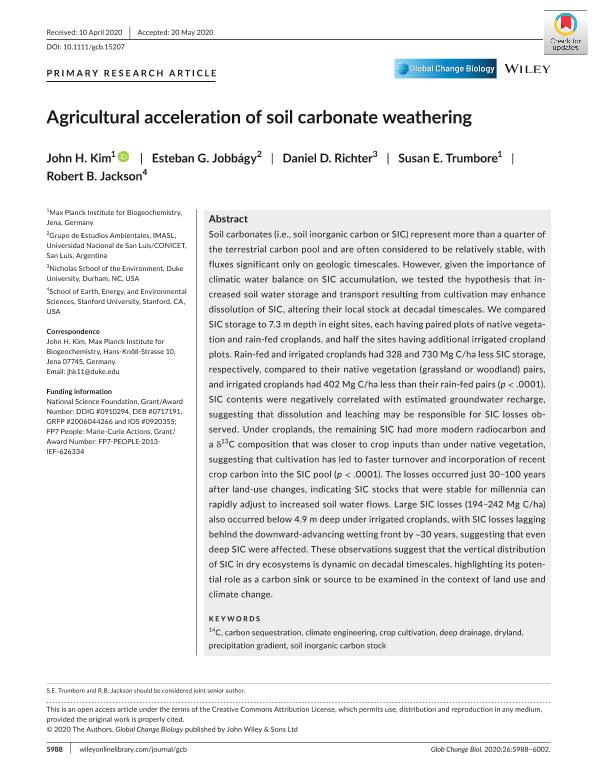Mostrar el registro sencillo del ítem
dc.contributor.author
Kim, John H.

dc.contributor.author
Jobbagy Gampel, Esteban Gabriel

dc.contributor.author
Richter, Daniel D.
dc.contributor.author
Trumbore, Susan E.
dc.contributor.author
Jackson, Robert B.

dc.date.available
2023-01-03T14:17:51Z
dc.date.issued
2020-10
dc.identifier.citation
Kim, John H.; Jobbagy Gampel, Esteban Gabriel; Richter, Daniel D.; Trumbore, Susan E.; Jackson, Robert B.; Agricultural acceleration of soil carbonate weathering; Wiley Blackwell Publishing, Inc; Global Change Biology; 26; 10; 10-2020; 5988-6002
dc.identifier.issn
1354-1013
dc.identifier.uri
http://hdl.handle.net/11336/183159
dc.description.abstract
Soil carbonates (i.e., soil inorganic carbon or SIC) represent more than a quarter of the terrestrial carbon pool and are often considered to be relatively stable, with fluxes significant only on geologic timescales. However, given the importance of climatic water balance on SIC accumulation, we tested the hypothesis that increased soil water storage and transport resulting from cultivation may enhance dissolution of SIC, altering their local stock at decadal timescales. We compared SIC storage to 7.3 m depth in eight sites, each having paired plots of native vegetation and rain-fed croplands, and half the sites having additional irrigated cropland plots. Rain-fed and irrigated croplands had 328 and 730 Mg C/ha less SIC storage, respectively, compared to their native vegetation (grassland or woodland) pairs, and irrigated croplands had 402 Mg C/ha less than their rain-fed pairs (p <.0001). SIC contents were negatively correlated with estimated groundwater recharge, suggesting that dissolution and leaching may be responsible for SIC losses observed. Under croplands, the remaining SIC had more modern radiocarbon and a δ13C composition that was closer to crop inputs than under native vegetation, suggesting that cultivation has led to faster turnover and incorporation of recent crop carbon into the SIC pool (p <.0001). The losses occurred just 30–100 years after land-use changes, indicating SIC stocks that were stable for millennia can rapidly adjust to increased soil water flows. Large SIC losses (194–242 Mg C/ha) also occurred below 4.9 m deep under irrigated croplands, with SIC losses lagging behind the downward-advancing wetting front by ~30 years, suggesting that even deep SIC were affected. These observations suggest that the vertical distribution of SIC in dry ecosystems is dynamic on decadal timescales, highlighting its potential role as a carbon sink or source to be examined in the context of land use and climate change.
dc.format
application/pdf
dc.language.iso
eng
dc.publisher
Wiley Blackwell Publishing, Inc

dc.rights
info:eu-repo/semantics/openAccess
dc.rights.uri
https://creativecommons.org/licenses/by/2.5/ar/
dc.subject
14C
dc.subject
CARBON SEQUESTRATION
dc.subject
CLIMATE ENGINEERING
dc.subject
CROP CULTIVATION
dc.subject
DEEP DRAINAGE
dc.subject
DRYLAND
dc.subject
PRECIPITATION GRADIENT
dc.subject
SOIL INORGANIC CARBON STOCK
dc.subject.classification
Otras Ciencias de la Tierra y relacionadas con el Medio Ambiente

dc.subject.classification
Ciencias de la Tierra y relacionadas con el Medio Ambiente

dc.subject.classification
CIENCIAS NATURALES Y EXACTAS

dc.title
Agricultural acceleration of soil carbonate weathering
dc.type
info:eu-repo/semantics/article
dc.type
info:ar-repo/semantics/artículo
dc.type
info:eu-repo/semantics/publishedVersion
dc.date.updated
2021-09-07T13:51:00Z
dc.journal.volume
26
dc.journal.number
10
dc.journal.pagination
5988-6002
dc.journal.pais
Reino Unido

dc.journal.ciudad
Londres
dc.description.fil
Fil: Kim, John H.. Max Planck Institute For Biogeochemistry; Alemania
dc.description.fil
Fil: Jobbagy Gampel, Esteban Gabriel. Consejo Nacional de Investigaciones Científicas y Técnicas. Centro Científico Tecnológico Conicet - San Luis. Instituto de Matemática Aplicada de San Luis "Prof. Ezio Marchi". Universidad Nacional de San Luis. Facultad de Ciencias Físico, Matemáticas y Naturales. Instituto de Matemática Aplicada de San Luis "Prof. Ezio Marchi"; Argentina
dc.description.fil
Fil: Richter, Daniel D.. University of Duke; Estados Unidos
dc.description.fil
Fil: Trumbore, Susan E.. Max Planck Institute For Biogeochemistry; Alemania
dc.description.fil
Fil: Jackson, Robert B.. University of Stanford; Estados Unidos
dc.journal.title
Global Change Biology

dc.relation.alternativeid
info:eu-repo/semantics/altIdentifier/doi/http://dx.doi.org/10.1111/gcb.15207
Archivos asociados
